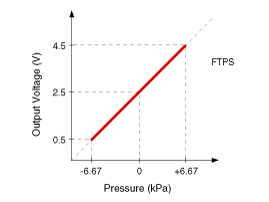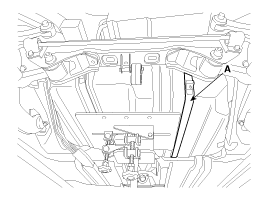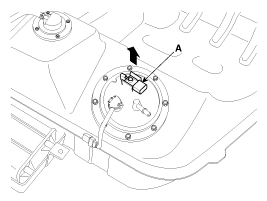Kia Optima Hybrid: Engine Control System / Fuel Tank Pressure Sensor (FTPS) Repair procedures
| Inspection |
| 1. |
Connect the GDS on the Data Link Connector (DLC). |
| 2. |
Measure the output voltage of the FTPS. |
| Pressure [kPa (kgf/cm?, in H2O) | Output Voltage (V) |
| -6.67 (-0.068, -26.8) | 0.5 |
| 0 | 2.5 |
| +6.67 (0.068, 26.8) | 4.5 |

| Removal |
| 1. |
Turn the ignition switch OFF and disconnect the battery negative (-) terminal. |
| 2. |
Lift the vehicle. |
| 3. |
Remove the canister. (Refer to Emission Control System - "Canister") |
| 4. |
Support the fuel tank with a jack and then remove the right fuel tank band (A).
|
| 5. |
Make a gap for removing the fuel tank pressure sensor by lowering the jack. |
| 6. |
Remove the fuel tank pressure sensor (A) by unfastening the hook.
|
| Installation |
|
| 1. |
Install in the reverse order of removal. |
 Fuel Tank Pressure Sensor (FTPS) Schematic Diagrams
Fuel Tank Pressure Sensor (FTPS) Schematic Diagrams
Circuit Diagram ...
 Injector Description and Operation
Injector Description and Operation
Description Based on information from various sensors, the ECM can calculate the fuel amount to be injected. The fuel injector is a solenoid-operated valve and the fuel injection amount is controlled by ...
Other information:
Kia Optima Hybrid (TF HEV) 2016-2020 Service Manual: High Mounted stop lamp Repair procedures
Removal 1. Disconnect the negative(-) battery terminal. 2. Remove the rear seat. (Refer to the BD group - "Rear seat") 3. Remove the package tray trim (A). (Refer to the BD group -"Interior trim") 4. Remove the soundproofing felt (A) to remove the wiring. 5. Remove the high mounted stop lamp after removing ...
Kia Optima Hybrid (TF HEV) 2016-2020 Service Manual: Transaxle Oil Temperature Sensor Specifications
Specifications Type: Negative Thermal Coefficient Type Temp.(°C)°FResistance (k?)(-40)-4046.8(-20)-4.015.6(0)32.05.88(20)68.02.51(40)104.01.17(60)140.00.59(80)176.00.32(100)212.00.18(120)248.00.11(140)284.00.07(165)329.00.04 ...



